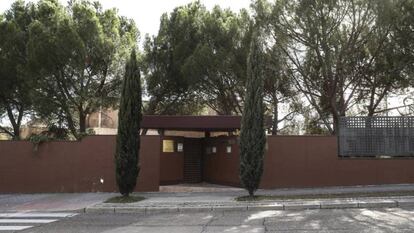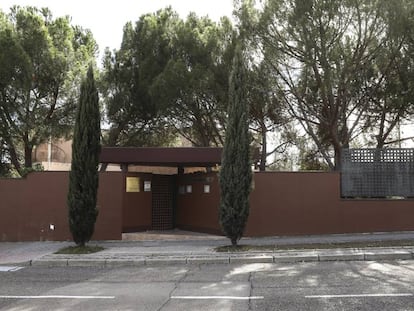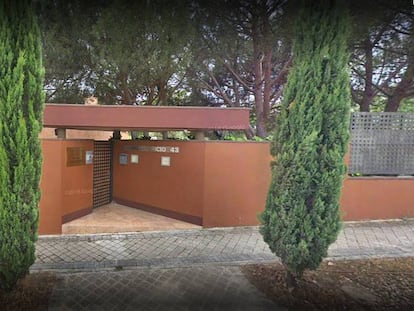North Korean embassy assailants filmed the attack to prove their actions, say Spanish police
Investigators say the group used micro-cameras to provide evidence of the raid to whoever ordered and financed the operation

The 10 individuals who broke into the North Korean embassy in Madrid last month, assaulting staff members and taking audiovisual material with them, had micro-cameras that they used to provide evidence of their actions to whoever ordered and financed the operation, according to Spanish investigators.
The only thing the assailants did not plan for was the fact that a woman would manage to jump out an embassy window
Police sources said these recordings are different from the video recently reported on by The Washington Post, where a person is seen breaking portraits of North Korean leaders inside a room with no positive identifying elements in it.
On Tuesday, investigating Judge José de la Mata, of Spain’s High Court, Audiencia Nacional, issued international arrest warrants against some of the intruders.
The leader of the group that broke into the embassy on February 22 has been named as Adrian Hong Chang, whom sources familiar with the investigation describe as “a North Korean mercenary.” The 35-year-old is a US resident with a Mexican passport who “owns several dubious companies and is in contact with various intelligence services.”
Investigators are now exploring whether Hong Chang played a role “in other violent incidents against North Korean interests in other countries.” Near the Madrid embassy, the police found an Italian driver’s license belonging to Hong Chang but showing a fake name. The North Korean ambassador to Italy has been missing since January, and is presumed to have defected.
The CIA link
Investigators soon linked two of the assailants with the CIA. It was not until March 19, nearly a month after the attack and with the Spanish police investigation nearly completed, that the FBI told Spanish authorities it had been contacted by Adrian Hong Chang.
According to the judge’s report, the group leader got in touch with the FBI on February 27, five days after the operation, to share information and hand over the material obtained in Madrid. Hong Chang was not arrested, and Spanish authorities were only informed after the story had made news headlines.
Spanish authorities contacted the CIA, which offered an “unconvincing” reply. Sources at the US embassy in Madrid said they do not comment on intelligence matters being handled by Spanish authorities, and that even if there had been any kind of official or informal call, no comments would be provided either.
Investigation sources say the attack was perfectly planned down to every last detail, something that would require “significant infrastructure and financing, which the individuals involved lack.”
Five days after leading the Madrid assault and flying to the United States, Hong allegedly contacted the FBI to share the material he obtained at the diplomatic compound, even though the CIA is the agency in charge of monitoring the North Korean nuclear program. (see box)
Investigators believe that the intruders were looking for “sensitive information regarding North Korea’s nuclear and arms program” just days ahead of the Hanoi summit between North Korean leader Kim Jong-un and US President Donald Trump, which ended abruptly without a deal.
The head of the North Korean delegation at the talks with the US was Kim Hyok Chol, who served as the ambassador to Spain until September 2017, when he was expelled from Spain over the nuclear testing program.
Investigation sources said that the violence employed against the current head of the embassy, the commercial attaché Yun Sok So, was due to the fact that the intruders “wanted him to tell them the location of the documents and files that they knew for a fact were in there.” Other sources said that the assailants were looking for compromising information about the former ambassador.
The attackers took the attaché to a room, beat him, and “offered to take him out of Spain to a safe place, if he would repudiate the North Korean regime.” Yun Sok So refused to do so.
Operation Nollan
Even though the assailants – mostly young South Koreans living in the US and trained in military action – took away the hard drives of the embassy’s security cameras, the police was able to partially recover the footage before its automatic deletion. This is what allowed investigators to observe the intruders’ “extremely violent and professional” behavior, and to identify them.
Four days after the break-in, investigators from the Madrid Provincial Information Brigade – which has also headed investigations into Islamist groups in Spain – had identified the group leader. The following week, most of his accomplices had been named as well.
The only thing the assailants did not plan for was the fact that a woman would manage to jump out an embassy window and alert the police while they were still inside.
This element of surprise – which gives the police operation its codename, Nollan (amazement in Korean) – forced the group to change its plans. Eight of them fled in embassy vehicles, while Hong Chan and an aide jumped over the back wall, ditching their weapons in the bushes, where they were later found by the police. These two then used the Uber app to request a vehicle, and left when the police was already outside the front door.
Operation Nollan has positively identified at least seven of the assailants after investigators watched thousands of hours’ worth of security camera footage from transportation hubs, hotels and other establishments, and after sending out international information requests. The police has also been offering protection to the victims of the attack, some of whom were treated at a Madrid hospital.
At the time of the attack, there were seven people inside the diplomatic compound, including staff members and visitors.
English version by Susana Urra.
Tu suscripción se está usando en otro dispositivo
¿Quieres añadir otro usuario a tu suscripción?
Si continúas leyendo en este dispositivo, no se podrá leer en el otro.
FlechaTu suscripción se está usando en otro dispositivo y solo puedes acceder a EL PAÍS desde un dispositivo a la vez.
Si quieres compartir tu cuenta, cambia tu suscripción a la modalidad Premium, así podrás añadir otro usuario. Cada uno accederá con su propia cuenta de email, lo que os permitirá personalizar vuestra experiencia en EL PAÍS.
¿Tienes una suscripción de empresa? Accede aquí para contratar más cuentas.
En el caso de no saber quién está usando tu cuenta, te recomendamos cambiar tu contraseña aquí.
Si decides continuar compartiendo tu cuenta, este mensaje se mostrará en tu dispositivo y en el de la otra persona que está usando tu cuenta de forma indefinida, afectando a tu experiencia de lectura. Puedes consultar aquí los términos y condiciones de la suscripción digital.
More information
Archived In
Últimas noticias
Most viewed
- Reinhard Genzel, Nobel laureate in physics: ‘One-minute videos will never give you the truth’
- Oona Chaplin: ‘I told James Cameron that I was living in a treehouse and starting a permaculture project with a friend’
- Pablo Escobar’s hippos: A serious environmental problem, 40 years on
- Chevy Chase, the beloved comedian who was a monster off camera: ‘Not everyone hated him, just the people who’ve worked with him’
- Why we lost the habit of sleeping in two segments and how that changed our sense of time










































